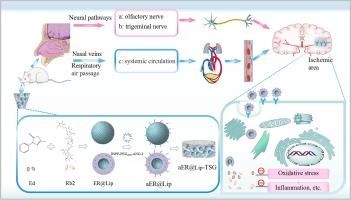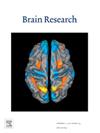A coloaded liposome in situ gel as a novel therapeutic strategy to treat cerebral ischemia reperfusion injury
IF 2.7
4区 医学
Q3 NEUROSCIENCES
引用次数: 0
Abstract
Background
Ischemic stroke has become one of the leading causes of death and disability worldwide in individuals aged 60 and above. However, currently available drugs show limited efficacy. Therefore, research to find more effective and safer therapeutic strategies is an urgent requirement for the treatment of cerebral ischemia reperfusion injury (CIRI).
Methods
First, the free radical scavenger Edaravone and a Ginseng active ingredient were coloaded into liposomes (aER@Lip), followed by optimization and characterization. Pluronic F127 and F68 at different concentrations were mixed and stored at 4 °C for more than 24 h to obtain gel solutions. Then, aER@Lip was added to the gel solutions to prepare the drug-loaded in situ gel, termed aER@Lip-TSG.
Results
In vitro experiments showed that aER@Lip-TSG was taken up by cells and had a good protective effect on oxygen-glucose deprivation/reoxygenation in pheochromocytoma 12 cells. In a rat CIRI model, aER@Lip-TSG delivered by intranasal administration not only decreased the apoptosis in brain tissue induced by CIRI, but also decreased the resultant inflammatory response. Moreover, the results suggested that aER@Lip-TSG had good biosafety.
Conclusion
This delivery system provides a promising multi-factor combination, synergistic effects, sustained-release capabilities, and is a non-invasive treatment strategy for CIRI. It thus meets the urgent need for effective treatments of central nervous system diseases.

将胶体脂质体原位凝胶作为治疗脑缺血再灌注损伤的一种新型治疗策略。
背景:缺血性中风已成为全球 60 岁及以上人群死亡和残疾的主要原因之一。然而,现有药物的疗效有限。因此,研究更有效、更安全的治疗策略是治疗脑缺血再灌注损伤(CIRI)的迫切要求:首先,将自由基清除剂依达拉奉和人参有效成分加入脂质体(aER@Lip)中,然后进行优化和表征。将不同浓度的 Pluronic F127 和 F68 混合并在 4 °C 下储存 24 小时以上,得到凝胶溶液。然后将 aER@Lip 添加到凝胶溶液中,制备药物负载原位凝胶,称为 aER@Lip-TSG.Results:体外实验表明,aER@Lip-TSG能被细胞吸收,并对嗜铬细胞瘤12细胞的氧-葡萄糖剥夺/缺氧有良好的保护作用。在大鼠 CIRI 模型中,aER@Lip-TSG 通过鼻内给药不仅减少了 CIRI 诱导的脑组织凋亡,还降低了由此引起的炎症反应。此外,研究结果表明,aER@Lip-TSG 具有良好的生物安全性:该递送系统具有多因素组合、协同效应、持续释放能力等优点,是一种非侵入性的 CIRI 治疗策略。因此,它满足了有效治疗中枢神经系统疾病的迫切需要。
本文章由计算机程序翻译,如有差异,请以英文原文为准。
求助全文
约1分钟内获得全文
求助全文
来源期刊

Brain Research
医学-神经科学
CiteScore
5.90
自引率
3.40%
发文量
268
审稿时长
47 days
期刊介绍:
An international multidisciplinary journal devoted to fundamental research in the brain sciences.
Brain Research publishes papers reporting interdisciplinary investigations of nervous system structure and function that are of general interest to the international community of neuroscientists. As is evident from the journals name, its scope is broad, ranging from cellular and molecular studies through systems neuroscience, cognition and disease. Invited reviews are also published; suggestions for and inquiries about potential reviews are welcomed.
With the appearance of the final issue of the 2011 subscription, Vol. 67/1-2 (24 June 2011), Brain Research Reviews has ceased publication as a distinct journal separate from Brain Research. Review articles accepted for Brain Research are now published in that journal.
 求助内容:
求助内容: 应助结果提醒方式:
应助结果提醒方式:


